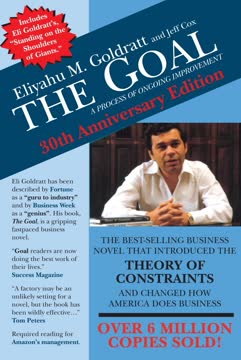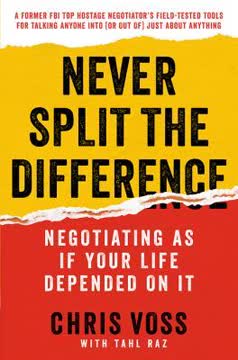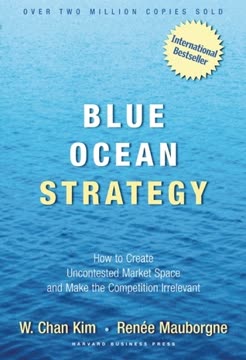मुख्य निष्कर्ष
1. समस्या से लोगों को अलग करें: पदों पर नहीं, हितों पर ध्यान दें
बातचीत की मूल समस्या विरोधी पदों में नहीं, बल्कि दोनों पक्षों की आवश्यकताओं, इच्छाओं, चिंताओं और भय के टकराव में होती है।
पदों पर आधारित सौदेबाजी से बचें। पदों पर अटके रहना अक्सर अनुचित समझौतों और रिश्तों को नुकसान पहुंचाता है। इसके बजाय, उन पदों के पीछे छिपे हितों पर ध्यान केंद्रित करें। यह तरीका रचनात्मक समाधान खोजने और दोनों पक्षों के लिए लाभकारी परिणाम पाने में मदद करता है।
रिश्तों की समस्याओं को विषयगत मुद्दों से अलग करें। लोगों से जुड़ी समस्याओं को सीधे संबोधित करें, बिना मुद्दों पर समझौता किए उन्हें शांत करने की कोशिश किए। एक ऐसा कार्य संबंध बनाएं जो मुद्दों पर सहमति या असहमति से स्वतंत्र हो। इससे आप लोगों के प्रति नरम और समस्या के प्रति सख्त रह सकते हैं।
- समस्या से लोगों को अलग करने के मुख्य तत्व:
- अपनी और उनकी भावनाओं को पहचानें और समझें
- सक्रिय रूप से सुनें और जो कहा जा रहा है उसे स्वीकार करें
- अपने बारे में बात करें, उनके बारे में नहीं
- केवल भावनाओं को व्यक्त करने के लिए नहीं, बल्कि उद्देश्य के साथ बोलें
2. दूसरे पक्ष के दृष्टिकोण और हितों को समझें
यदि आप चाहते हैं कि दूसरा पक्ष आपके हितों को समझे, तो पहले यह दिखाएं कि आप उनके हितों की कद्र करते हैं।
सहानुभूति अत्यंत आवश्यक है। उनकी जगह खुद को रखकर उनकी दृष्टि को समझने की कोशिश करें, भले ही आप सहमत न हों। इसका मतलब सहमति नहीं, बल्कि उनकी सोच को समझना है। जब आप उनके हितों को समझते हैं, तो वे भी आपके हितों को सुनने के लिए अधिक तैयार होते हैं।
छिपे हुए हितों को खोजें। केवल घोषित पदों से आगे जाकर मूल हितों की पहचान करें। "क्यों?" और "क्यों नहीं?" पूछकर उनकी प्रेरणाओं और चिंताओं को उजागर करें। याद रखें कि हर पक्ष के कई हित होते हैं, केवल एक नहीं।
- सामान्य हित जिन पर ध्यान दें:
- मूल मानव आवश्यकताएं (सुरक्षा, आर्थिक स्थिरता, अपनापन, मान्यता, जीवन पर नियंत्रण)
- रिश्तों को बनाए रखने, लागत कम करने या संघर्ष से बचने के साझा हित
- पूरक हित जो दोनों पक्षों के लाभ के लिए मेल खा सकते हैं
3. निर्णय लेने से पहले पारस्परिक लाभ के लिए कई विकल्प बनाएं
पहले आविष्कार करें, बाद में निर्णय लें।
जल्दी निर्णय लेने से बचें। विकल्प बनाने की रचनात्मक प्रक्रिया को चयन की आलोचनात्मक प्रक्रिया से अलग रखें ताकि अधिक नवाचारी समाधान मिल सकें। बिना आलोचना के विचार-मंथन करें ताकि उपलब्ध संसाधन बढ़ सकें।
साझा लाभ खोजें। ऐसे हितों की पहचान करें जो साझा या संगत हों, फिर ऐसे विकल्प बनाएं जो उन हितों को पूरा करें। हितों, विश्वासों या संसाधनों के अंतर का उपयोग दोनों पक्षों के लिए मूल्य बनाने में करें।
- विकल्प बनाने की तकनीकें:
- स्पष्ट नियमों के साथ विचार-मंथन सत्र
- समस्या को विभिन्न विशेषज्ञ दृष्टिकोण से देखें
- एक पक्ष के लिए कम महत्वपूर्ण मुद्दों को दूसरे पक्ष के अधिक महत्वपूर्ण मुद्दों के साथ जोड़ने के अवसर खोजें
- संभावित समझौतों के विभिन्न संस्करण विकसित करें (जैसे कड़े/नरम, व्यापक/संकीर्ण, लंबी/छोटी अवधि)
4. समाधान का मूल्यांकन और चयन करने के लिए वस्तुनिष्ठ मानदंडों का उपयोग करें
वस्तुनिष्ठ मानदंडों के उपयोग पर जोर दें।
निर्णय सिद्धांतों पर आधारित हों, दबाव पर नहीं। संभावित समाधानों का न्याय करने के लिए निष्पक्ष मानक या प्रक्रियाओं पर सहमति बनाएं। इससे समझौता आसान होता है और इच्छाशक्ति के टकराव से बचा जा सकता है।
तर्क के लिए खुले रहें। अपने पक्ष में मानकों का समर्थन करते हुए, दूसरे पक्ष के सुझावों को भी स्वीकार करें। यह तय करें कि कौन से मानक आपकी स्थिति के लिए सबसे उपयुक्त हैं।
- वस्तुनिष्ठ मानदंडों के उदाहरण:
- बाजार मूल्य
- पूर्ववर्ती उदाहरण
- वैज्ञानिक निर्णय
- पेशेवर मानक
- दक्षता
- लागत
- न्यायालय का निर्णय
- नैतिक मानक
- समान व्यवहार
- परंपरा
- पारस्परिकता
5. अपनी BATNA (सर्वोत्तम वैकल्पिक समझौता) विकसित करें
आप इसलिए बातचीत करते हैं ताकि बिना बातचीत के मिलने वाले परिणाम से बेहतर कुछ हासिल कर सकें।
अपना छोड़ने का बिंदु जानें। आपकी BATNA वह मानक है जिसके आधार पर किसी भी प्रस्तावित समझौते को मापा जाना चाहिए। यह आपकी बातचीत की ताकत निर्धारित करता है और आपको अनुचित शर्तें स्वीकार करने या उचित शर्तें ठुकराने से बचाता है।
अपनी BATNA को बेहतर बनाएं। जितनी बेहतर आपकी BATNA होगी, आपकी बातचीत में उतनी ही अधिक ताकत होगी। अपनी वैकल्पिक योजनाओं को सक्रिय रूप से सुधारें।
- BATNA विकसित करने के चरण:
- उन कार्यों की सूची बनाएं जो आप समझौता न होने पर कर सकते हैं
- कुछ आशाजनक विचारों को सुधारें और व्यावहारिक विकल्पों में बदलें
- सबसे अच्छा विकल्प चुनें, प्रारंभिक रूप से
6. कठिन रणनीतियों का सामना बातचीत जुझित्सु से करें
पीछे धकेलें नहीं। जब वे अपने पदों पर अड़े हों, उन्हें अस्वीकार न करें। जब वे आपके विचारों पर हमला करें, बचाव न करें। जब वे आप पर हमला करें, पलटवार न करें। प्रतिक्रिया देने से इनकार करके नकारात्मक चक्र तोड़ें।
चतुर रणनीतियों को पहचानें और निष्प्रभावी बनाएं। जानें कि धोखा, मनोवैज्ञानिक युद्ध और पद आधारित दबाव जैसी चालें आम हैं। इनके जवाब में समान प्रतिक्रिया देने के बजाय, ध्यान समस्या के गुणों की ओर मोड़ें।
प्रश्न और मौन का उपयोग करें। हितों को समझने, अपने विचारों की आलोचना आमंत्रित करने और उनके पदों के पीछे तर्क जानने के लिए प्रश्न पूछें। मौन एक शक्तिशाली उपकरण है जो दूसरे पक्ष को पुनर्विचार या विस्तार करने के लिए प्रोत्साहित करता है।
- बातचीत जुझित्सु के मुख्य तत्व:
- आप पर हमलों को समस्या की ओर मोड़ें
- उनके हमलों को समस्या पर हमले के रूप में पुनः व्याख्यायित करें
- प्रश्न पूछें और ठहराव करें
- मौन का रणनीतिक उपयोग करें
7. व्यक्तित्व, संस्कृति और शक्ति के अंतर को पार करें
स्थिति को दूसरे पक्ष की दृष्टि से देख पाना, चाहे वह कितना भी कठिन क्यों न हो, एक सफल वार्ताकार की सबसे महत्वपूर्ण क्षमताओं में से एक है।
व्यक्तिगत और सांस्कृतिक भिन्नताओं के अनुसार अनुकूलित हों। संचार शैली, मूल्य और निर्णय प्रक्रिया में अंतर के प्रति संवेदनशील रहें। बिना पूर्वाग्रह के वास्तविक सांस्कृतिक भिन्नताओं का सम्मान करें।
शक्ति असंतुलन से निपटें। जब अधिक शक्तिशाली प्रतिद्वंद्वी का सामना हो, तो हितों और वस्तुनिष्ठ मानदंडों पर ध्यान दें। अपनी BATNA विकसित और सुधारें ताकि आपकी बातचीत की ताकत बढ़े।
- सांस्कृतिक अंतरराष्ट्रीय वार्ताओं के लिए विचार:
- चर्चा की गति और औपचारिकता
- रिश्तों की तुलना में लेन-देन का महत्व
- प्रत्यक्ष बनाम अप्रत्यक्ष संचार शैली
- अल्पकालिक बनाम दीर्घकालिक दृष्टिकोण
- व्यक्तिगत बनाम सामूहिक निर्णय लेना
8. विकल्पों के आविष्कार से प्रतिबद्धता की ओर धीरे-धीरे बढ़ें
अपने हितों के लिए दृढ़ रहें, लेकिन किसी एक समाधान के लिए कठोर न बनें।
शुरुआत से ही समझौते की समाप्ति के बारे में सोचें। सफल समझौते की कल्पना करें और पीछे से आवश्यक कदम और संभावित बाधाओं की पहचान करें।
एक रूपरेखा समझौता बनाएं। अंतिम समझौते के लिए एक रूपरेखा या टेम्पलेट तैयार करें ताकि सभी महत्वपूर्ण मुद्दे शामिल हों और चर्चा के लिए संरचना मिले।
- प्रतिबद्धता की ओर बढ़ने के चरण:
- चलते-चलते संभावित शर्तों का मसौदा बनाएं, प्रतिबद्धताओं को अस्थायी रखें
- प्रत्येक मुद्दे के विकल्पों की सीमा संकुचित करें
- आवश्यकतानुसार मुद्दों पर पुनः विचार करें, विशिष्ट बिंदुओं और समग्र पैकेज के बीच गतिशील रहें
- जब प्रस्तावों को चुनौती मिले तो अंतर्निहित हित समझाएं
- नई जानकारी या तर्क से प्रभावित होकर अपनी सोच में बदलाव के लिए तैयार रहें
9. समस्या पर सख्ती, लोगों पर नरमी बरतें
लोगों को समस्या से अलग करें।
रिश्तों की समस्याओं को सीधे संबोधित करें। लोगों से जुड़ी समस्याओं को मुद्दों पर समझौता किए बिना हल करें। बातचीत के परिणाम से स्वतंत्र रूप से विश्वास और मेलजोल बनाएं।
पदों पर नहीं, हितों पर ध्यान दें। दोनों पक्षों की आवश्यकताओं और चिंताओं पर ध्यान देकर ऐसे समाधान खोजें जो सभी को संतुष्ट करें, बिना किसी पक्ष को अपने पद से पीछे हटने के लिए मजबूर किए।
- समस्या पर सख्ती, लोगों पर नरमी बरतने की तकनीकें:
- "मैं" वक्तव्य का उपयोग करें ताकि अपनी चिंता व्यक्त करें बिना हमला किए
- भावनाओं और धारणाओं को स्वीकार करें, जरूरी नहीं कि सहमत हों
- व्यक्तिगत हमलों को संयुक्त समस्याओं के रूप में पुनः प्रस्तुत करें
- दूसरे पक्ष के सकारात्मक इरादों या प्रयासों का समर्थन करने के अवसर खोजें
10. आवश्यक होने पर बातचीत की प्रक्रिया पर ही बातचीत करें
प्रत्येक मुद्दे को वस्तुनिष्ठ मानदंडों की संयुक्त खोज के रूप में प्रस्तुत करें।
बातचीत की प्रक्रिया के बारे में स्पष्ट रहें। यदि दूसरा पक्ष ऐसी रणनीतियाँ अपनाए जो आप उत्पादक या निष्पक्ष न समझें, तो इसे सीधे उठाएं। बातचीत के तरीके पर ही बातचीत करें।
वैकल्पिक दृष्टिकोण प्रस्तावित करें। यदि पद आधारित सौदेबाजी काम नहीं कर रही, तो हितों और वस्तुनिष्ठ मानदंडों पर आधारित सिद्धांतवादी बातचीत या अन्य तरीकों का सुझाव दें।
- प्रक्रिया पर बातचीत के चरण:
- समस्या पैदा करने वाली रणनीति या व्यवहार को पहचानें
- इसे दूसरे पक्ष के सामने स्पष्ट रूप से उठाएं
- उस रणनीति की वैधता और प्रभावशीलता पर सवाल उठाएं
- हितों और वस्तुनिष्ठ मानदंडों के सिद्धांतों का उपयोग करते हुए इस पर बातचीत करें
अंतिम अपडेट:
FAQ
What's "Getting to Yes" about?
- Principled Negotiation: "Getting to Yes" by Roger Fisher, William Ury, and Bruce Patton introduces the concept of principled negotiation, which focuses on interests rather than positions.
- Conflict Resolution: The book provides a framework for resolving disputes amicably and efficiently, aiming for mutually beneficial outcomes.
- Universal Application: It applies to various negotiation scenarios, from personal to international conflicts, emphasizing a method that is both hard on the merits and soft on the people involved.
Why should I read "Getting to Yes"?
- Improved Negotiation Skills: The book offers practical strategies to enhance your negotiation abilities, making you more effective in both personal and professional settings.
- Conflict Management: It provides tools to manage and resolve conflicts without damaging relationships, which is crucial in maintaining long-term partnerships.
- Broad Applicability: The principles can be applied across different contexts, making it a valuable resource for anyone who negotiates regularly.
What are the key takeaways of "Getting to Yes"?
- Focus on Interests: Instead of bargaining over positions, identify and address the underlying interests of both parties.
- Invent Options for Mutual Gain: Encourage creative solutions that satisfy the interests of all parties involved.
- Use Objective Criteria: Base agreements on fair standards rather than the will of either party, ensuring a more equitable outcome.
What is the principled negotiation method in "Getting to Yes"?
- Separate People from Problems: Address the human aspects of negotiation separately from the substantive issues to prevent personal conflicts from derailing discussions.
- Focus on Interests, Not Positions: Understand the underlying needs and desires that drive each party's stance to find common ground.
- Insist on Objective Criteria: Use fair, independent standards to guide the negotiation process and reach a just agreement.
How does "Getting to Yes" suggest handling more powerful opponents?
- Develop Your BATNA: Strengthen your Best Alternative to a Negotiated Agreement to protect yourself from unfavorable deals.
- Leverage Objective Criteria: Use fair standards to level the playing field, even when the other party holds more power.
- Focus on Interests: By concentrating on mutual interests, you can find solutions that benefit both parties, regardless of power dynamics.
What if the other side won't play by the rules in "Getting to Yes"?
- Negotiation Jujitsu: Redirect their attacks on you or your ideas back to the problem, avoiding direct confrontation.
- One-Text Procedure: Involve a third party to help both sides focus on interests and options rather than positions.
- Stay Principled: Maintain your focus on interests, options, and criteria, encouraging the other side to engage in principled negotiation.
How does "Getting to Yes" address dirty tricks in negotiation?
- Recognize and Address Tactics: Identify deceptive or manipulative tactics and bring them to the other party's attention.
- Negotiate the Process: Discuss and agree on fair negotiation procedures to prevent the use of dirty tricks.
- Focus on Principles: Insist on negotiating based on objective criteria and mutual interests, rather than succumbing to pressure tactics.
What are some of the best quotes from "Getting to Yes" and what do they mean?
- "Separate the people from the problem": This emphasizes the importance of addressing interpersonal issues separately from the substantive negotiation topics.
- "Focus on interests, not positions": Encourages negotiators to look beyond stated demands to understand the underlying needs and motivations.
- "Invent options for mutual gain": Highlights the value of creative problem-solving to find solutions that benefit all parties involved.
How does "Getting to Yes" suggest dealing with people problems in negotiation?
- Build a Working Relationship: Establish a foundation of trust and understanding to facilitate smoother negotiations.
- Negotiate the Relationship: Address interpersonal issues directly and separately from substantive matters to prevent them from affecting the negotiation.
- Separate Treatment from Behavior: Treat the other party with respect, regardless of their behavior, to maintain a constructive dialogue.
What role does BATNA play in "Getting to Yes"?
- Protection Against Bad Deals: A strong BATNA ensures you don't accept an agreement worse than your best alternative.
- Leverage in Negotiation: Knowing your BATNA gives you confidence and power, as you have a clear alternative if negotiations fail.
- Improvement Strategy: Continuously work to improve your BATNA to enhance your negotiating position.
How does "Getting to Yes" recommend inventing options for mutual gain?
- Separate Inventing from Deciding: Brainstorm options without judgment to encourage creativity and innovation.
- Broaden Options: Consider a wide range of possibilities to increase the chances of finding mutually beneficial solutions.
- Dovetail Interests: Look for ways to align differing interests to create win-win outcomes.
How can "Getting to Yes" help in cross-cultural negotiations?
- Understand Differences: Be aware of cultural norms and values that may influence negotiation styles and preferences.
- Adapt Strategies: Tailor your approach to accommodate cultural differences while maintaining the principles of negotiation.
- Focus on Common Interests: Emphasize shared goals and interests to bridge cultural gaps and foster collaboration.
समीक्षाएं
Getting to Yes को समझौता करने की कला पर एक अनिवार्य मार्गदर्शिका के रूप में व्यापक रूप से सराहा जाता है, जो सिद्धांतों पर आधारित बातचीत के लिए व्यावहारिक रणनीतियाँ प्रस्तुत करती है। पाठक इसकी संक्षिप्त और क्रियान्वयन योग्य सलाह की प्रशंसा करते हैं, जिसमें वे स्थिति की बजाय हितों पर ध्यान केंद्रित करने, लोगों को समस्याओं से अलग करने और पारस्परिक लाभकारी समाधान खोजने की बात कहते हैं। कई लोगों ने इसे आँखें खोलने वाला और तुरंत विभिन्न जीवन परिस्थितियों में लागू करने योग्य पाया। हालांकि कुछ ने इसे सूखा या बुनियादी महसूस किया, फिर भी अधिकांश समीक्षक इसे उन सभी के लिए अत्यंत उपयोगी मानते हैं जो व्यवसायिक और व्यक्तिगत संदर्भों में अपनी बातचीत कौशल को सुधारना चाहते हैं।
Similar Books















